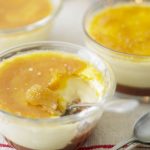
Classic crème brûlée
Please note: If you buy books linked to our site, we may earn a commission from Bookshop.org, whose fees support independent bookshops.
This classic dessert of creamy egg custard topped with the crackle of a caramelised sugar crust is pure, unadulterated joy.
A de rigeur bistro dessert, this simple cream-and-egg pudding is made sublime by the interplay of a warm, crunchy caramelised crust that contrasts with the creamy, cool custard below. You can serve the crème minus the brittle topping, either still warm from the oven or chilled, but it’s traditional to apply a flame to the surface to achieve the crisp top.
Related recipes:
The origins and evolution of crème brûlée
The origins of crème brûlée are shrouded in mystery, with several theories about its beginnings. Some food historians believe it originated in England, where it was known as “burnt cream,” while others believe it originated in France as “crème brûlée,” or in Spain as “crema catalana.”
Read Is crème brûlée French or English… or even Spanish?
The earliest known recipe for crème brûlée can be found in a French cookbook from the late 17th century called “Le Cuisinier Royal et Bourgeois” by Francois Massialot. The recipe called for cream, sugar, egg yolks, and vanilla, which are the same ingredients used in modern-day recipes. However, the recipe did not call for the caramelised sugar topping that is now a signature element of the dessert.
Over time, crème brûlée evolved to include the caramelised sugar topping, which involves sprinkling sugar on top of the custard and using a blowtorch or broiler to caramelise the sugar. This step not only adds a crispy texture to the dessert but also gives it a unique flavour.
Read Mastering the art of crème brûlée: step-by-step guide
Today, crème brûlée is a popular dessert enjoyed worldwide. It has become a staple in many restaurants and is often served at special occasions. Its rich history and evolution make it a dessert worth savouring, regardless of where it originated.
Recipe Card
Classic crème brûlée
Ingredients
- 6 egg yolks
- 1/4 cup 50g sugar, plus 3 tablespoons for the topping
- 2 cups 470g heavy/double cream
Instructions
- Preheat the oven to 300°F/150°C. Have ready six ramekins and a baking pan that is at least as deep as the ramekins and is large enough to accommodate them without crowding.
- In a medium bowl, whisk together the egg yolks and sugar until the sugar dissolves. In a small saucepan, heat the cream over medium-low heat, stirring constantly with a heat-resistant spatula to ensure it is not sticking to the pan bottom, until small bubbles appear along the edge of the liquid, about 3 minutes. Remove the cream from the heat. While whisking continuously, gradually add the hot cream in a thin stream to the egg yolks until fully blended.
- Strain the cream-egg yolk mixture through a fine-mesh sieve into a quart-size liquid measuring cup or a pitcher (to make filling the ramekins easier), then divide it evenly among the ramekins. Place the ramekins in the baking pan and add water to the pan to reach halfway up the sides of the ramekins. Carefully transport the baking pan to the oven and bake until the custards are set at the edges and quiver slightly in the centre when the ramekins are gently nudged, 45 to 50 minutes. To test, insert a small spoon into the centre of a ramekin; the custard should be thick enough to coat the back of the spoon. Draw your finger through the sauce on the back of the spoon; the track should remain clear. If not, cook for a bit longer.
- Remove the baking pan from the oven, then carefully transfer the ramekins to a wire rack and let cool to room temperature. Cover each ramekin with plastic wrap and refrigerate for at least 2 hours or, preferably, overnight (or up to 2 days).
- Just before serving, evenly sprinkle 1 1/2 teaspoons of the sugar over the top of a custard, rotating the custard as you sprinkle to ensure even distribution. Repeat with the remaining sugar and custards. Holding the flame of a kitchen torch about 2 inches above the custard, move the flame over the surface in a circular motion. The sugar will melt and bead, then solidify into a crust. Continue to heat the surface until it has turned a caramel colour, 1-2 minutes longer. (Keep in mind that the darker the crust, the more bitter it will taste.) Repeat with the remaining custards, then serve at once.
Extracted from Taste of France Issue Five.
Did you enjoy the recipe? Let us know in the comment section below.
Latest posts:
- Canard au sang
- Oeufs en meurette
- Le Goûter: The Sweetest Part of the Day
- Fabien Ferré: Jumping from 0 to 3 Michelin Stars
- Sardines and onions summer tart
Lead photo credit : (c) Shutterstock
Share to: Facebook Twitter LinkedIn Email
More in Classic french dessert, Easy crème brûlée, French crème brûlée, How to make crème brûlée







